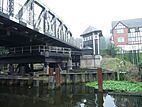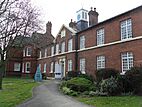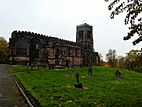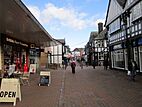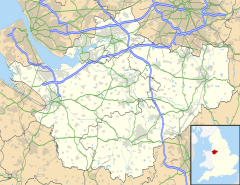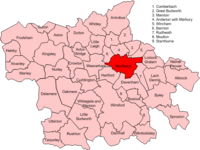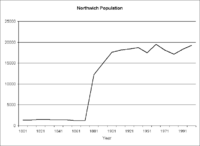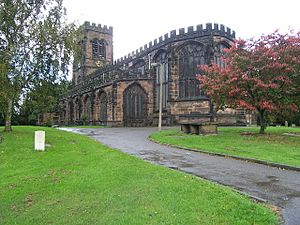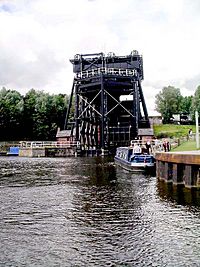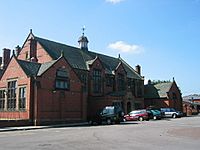Northwich facts for kids
Quick facts for kids Northwich |
|
|---|---|
|
|
|
| Population | 22,726 (2021) |
| OS grid reference | SJ651733 |
| Civil parish |
|
| Unitary authority |
|
| Ceremonial county | |
| Region | |
| Country | England |
| Sovereign state | United Kingdom |
| Post town | NORTHWICH |
| Postcode district | CW8, CW9 |
| Dialling code | 01606 |
| Police | Cheshire |
| Fire | Cheshire |
| Ambulance | North West |
| EU Parliament | North West England |
| UK Parliament |
|
Northwich is a lively market and port town in Cheshire, England. It sits in the middle of the Cheshire Plain, where the Weaver and Dane rivers meet. The town is about 18 miles east of Chester and 19 miles south of Manchester.
In 2021, the town's population was 20,924. If you include the nearby areas, the population was about 50,531. Northwich has been important for its salt since Roman times. Back then, it was called Condate. Salt mining caused problems like land sinking, but this issue was fixed in 2007.
Contents
- A Look Back at Northwich's Past
- Northwich Today: Development and Renewal
- How Northwich is Governed
- Northwich's Location and Landscape
- Northwich's Population Over Time
- Northwich's Economy and Jobs
- Culture and Community Life
- Media and Local News
- Sports and Recreation
- Important Buildings and Churches
- Getting Around Northwich: Transport
- Learning in Northwich: Education
- Famous People from Northwich
- Twin Towns
- Images for kids
- See also
A Look Back at Northwich's Past
Northwich's Roman Beginnings
During Roman times, Northwich was known as Condate. This name likely came from a Celtic word meaning "Confluence," because it's where the Dane and Weaver rivers join.
Roman documents from the 3rd and 7th centuries mention Condate. The Romans were interested in Northwich because of its rivers and valuable salt brines. Salt was very important to them, even influencing words like "salary" and "soldier."
Archaeologists have found evidence of a Roman fort in the area now called "Castle." This fort was built around AD 70 as the Romans moved north from Chester. The name "Northwich" itself comes from the Old Norse word wic, meaning "bay," which was used for places where salt was made. Northwich was the most northern of these "wich" towns in Cheshire.
From Medieval Times to the 1800s
Northwich is mentioned in the Domesday Book of 1086, showing it existed in early medieval times. The town was known for its salt production for centuries. In 1540, writer John Leland described Northwich as a "pratie market town" with large piles of wood used to boil salt water.
During the English Civil War (1642-1643), Northwich was a fortified town for the Parliamentarians. In the 1670s, large salt beds were found again by the Smith-Barry family near Marbury Hall.
The Impact of Salt Mining in the 19th Century
In the 1800s, it became cheaper to get salt by pumping hot water into the mines. This dissolved the salt, creating brine that was then pumped out. This method weakened the mines and caused the land above to sink. This sinking affected the town and surrounding areas. For example, in 1880, a large hole formed, and the River Weaver flowed into it, creating Witton Flash.
Many old timber-framed houses in the town centre were built to handle the ground movement. Some even had steel beams that could be jacked up to keep the house level! Today, the town's history with salt is celebrated at the Salt Museum, which is in the old workhouse.
In 1874, John Brunner and Ludwig Mond started the company Brunner Mond in Winnington. They made soda ash using salt. The chemical industry used the sunken land to dump waste from making soda ash. This waste created "limebeds," which were dangerous and made the land unusable for a long time.
Northwich Today: Development and Renewal
Northwich has seen many changes to fix the problems caused by salt mining.
- In 1975, Marbury Country Park was created from old industrial land. It's now a popular place for recreation.
- More land was cleaned up to create places like Furey Wood and Northwich Community Woodlands, which is a large public space.
In 2004, a big project began to make the abandoned salt mines under Northwich stable. This £28 million project involved removing millions of litres of brine and filling the mines with a special mixture of ash, cement, and salt. The work finished in 2007, making the town centre safer.
New buildings have also changed the town:
- The old Magistrates Court and Memorial Hall were replaced by Memorial Court, a modern cultural and leisure centre with a pool, dance studios, and a gym.
- The Barons Quay Development, a large shopping and leisure complex, opened in 2016. It brought new shops, a supermarket, a cinema, and restaurants to the town.
- Sadly, a major fire destroyed the Northwich Outdoor Market in January 2020. There are currently no plans to rebuild it.
How Northwich is Governed
Northwich has a long history of local government. It was mentioned in the Domesday survey in 1086. The town has grown over time, adding parts of nearby villages.
Today, Northwich is part of the Cheshire West and Chester council area. The civil parish of Northwich is served by the Northwich Town Council. In 2018, the Northwich Town Council won 'Council of the Year' for its great work!
The town's coat of arms has a Latin motto: "Sal est Vita", which means "Salt is Life". This reminds everyone of Northwich's strong connection to the salt industry. Northwich is also twinned with Dole in France and Carlow in Ireland.
Northwich's Location and Landscape
Northwich is located in the Cheshire Plain, about 15 to 35 meters above sea level. The Weaver and Dane rivers meet right in the town centre.
The area around Northwich has rolling green fields. Because of the land sinking from salt mining, there are also "flashes" (small lakes) and "meres" (natural lakes) nearby, like Budworth Mere and Pick Mere.
| Month | Jan | Feb | Mar | Apr | May | Jun | Jul | Aug | Sep | Oct | Nov | Dec | Year |
|---|---|---|---|---|---|---|---|---|---|---|---|---|---|
| Mean daily maximum °C (°F) | 6.9 (44.4) |
7.4 (45.3) |
9.6 (49.3) |
12.5 (54.5) |
16.2 (61.2) |
19.7 (67.5) |
20.3 (68.5) |
20.3 (68.5) |
17.9 (64.2) |
14.6 (58.3) |
9.8 (49.6) |
7.7 (45.9) |
13.6 (56.4) |
| Daily mean °C (°F) | 4.4 (39.9) |
4.6 (40.3) |
6.2 (43.2) |
8.8 (47.8) |
12.1 (53.8) |
15.2 (59.4) |
16.2 (61.2) |
16.2 (61.2) |
14.0 (57.2) |
11.1 (52.0) |
6.8 (44.2) |
5.0 (41.0) |
10.0 (50.1) |
| Mean daily minimum °C (°F) | 1.9 (35.4) |
1.9 (35.4) |
2.8 (37.0) |
5.0 (41.0) |
8.0 (46.4) |
10.7 (51.3) |
12.2 (54.0) |
12.1 (53.8) |
10.0 (50.0) |
7.7 (45.9) |
3.8 (38.8) |
2.3 (36.1) |
6.5 (43.8) |
| Average precipitation mm (inches) | 65.6 (2.58) |
44.2 (1.74) |
45.2 (1.78) |
57.2 (2.25) |
66.4 (2.61) |
55.0 (2.17) |
73.4 (2.89) |
75.7 (2.98) |
71.0 (2.80) |
63.9 (2.52) |
78.4 (3.09) |
68.5 (2.70) |
764.5 (30.11) |
| Source: CEDA | |||||||||||||
Northwich's Population Over Time
The population of Northwich has changed a lot over the years. In 1664, it was estimated to be only 560 people.
| Population of Northwich since 1801 | |||||||||||||||||||||
|---|---|---|---|---|---|---|---|---|---|---|---|---|---|---|---|---|---|---|---|---|---|
| Year | 1801 | 1811 | 1821 | 1831 | 1841 | 1851 | 1861 | 1871 | 1881 | 1891 | 1901 | 1911 | 1921 | 1931 | 1951 | 1961 | 1971 | 1981 | 1991 | 2001 | 2011 |
| Population | 1,338 | 1,382 | 1,490 | 1,481 | 1,368 | 1,377 | 1,190 | 1,244 | 12,256 | 14,914 | 17,611 | 18,151 | 18,381 | 18,732 | 17,489 | 19,592 | 18,136 | 17,098 | 18,316 | 19,259 | 19,924 |
| Sources: | |||||||||||||||||||||
In 2011, the population of Northwich civil parish was 19,924. This included 9,878 males and 10,046 females. There were 8,808 households, with an average size of 2.62 people.
When you include the nearby areas that use Northwich town centre, the total population was about 53,391 in 2011. By 2021, the population of Northwich and its urban area was estimated to be around 63,000.
Northwich's Economy and Jobs
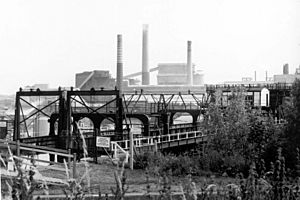
Northwich has been a market town since at least 1535. Even today, it still has a market that is planned for improvements.
Historically, the salt industry was the most important part of Northwich's economy. However, records from 1353 show that many other goods were traded in Northwich. These included animals, fabrics, fish, drinks, building materials, and metals. This shows that Northwich had a diverse economy, not just salt.
The salt industry also led to a large chemical industry. Companies like ICI had big factories in Winnington, Wallerscote, and Lostock. In fact, the first way to make polythene (a common plastic) was accidentally discovered at the Winnington Laboratory in 1933!
The well-known bakers Frank Roberts & Sons have been connected to Northwich since 1887. They are still based nearby in Rudheath. Many other major companies also have offices and factories in the areas around Northwich.
In 2001, about 64% of people aged 16 to 74 in Northwich were working or looking for work.
Culture and Community Life
Northwich hosts several exciting annual events:
- The Northwich Festival is held every August Bank Holiday weekend. It features four days of music and sports at Moss Farm Sports Complex.
- Since 2021, Northwich has held an annual Piña Colada Festival! This celebrates Rupert Holmes, who was born in the town and wrote the famous song "Escape (The Piña Colada Song)". The festival has live music, rides, and tropical treats.
The Memorial Court Facility opened in 2015. It replaced the old Northwich Memorial Hall and offers a variety of activities, including shows, music events, and comedy clubs. The Harlequin Theatre puts on six plays each year and is also home to the Northwich Folk Club.
A new cinema opened in the Barons Quay development in 2016. The local newspaper is the Northwich Guardian, and Radio Northwich is a popular community radio station.
Northwich has produced some famous musicians, including Steve Hewitt, the drummer for the band Placebo, and Tim Burgess, the lead singer of The Charlatans. Local author Stuart Neild sets some of his horror novels in the salt mines under Northwich.
Media and Local News
Local news and TV shows for Northwich are provided by BBC North West and ITV Granada. You can also listen to radio stations like BBC Radio Merseyside, BBC Radio Stoke, and the local community station, Radio Northwich. The Northwich Guardian newspaper is published every Wednesday.
Sports and Recreation
Northwich is a great place for sports!
- Football: The town is home to three non-league football teams: Witton Albion, Northwich Victoria, and 1874 Northwich. There are even plans for a large new football development near Northwich.
- Rugby: Northwich has two rugby union teams: Northwich RUFC and Winnington Park.
- Cricket: Several amateur cricket clubs play in the area, including Winnington Park CC and Davenham CC.
- Swimming: The Northwich Swimming Club has been around since the late 1800s and has a successful competitive team.
- Rowing: Northwich Rowing Club was formed in 1875 and rows on the River Weaver. They have produced Olympic rowers and hold three events each year. The club has a large junior section for rowers aged 12 and up.
- Cycling: The Weaver Valley CC cycling club was started in 1962. They compete in various cycling races and promote the Cheshire Classic women's cycling road race, which is a long-running national event.
The UK Strongman-North Competition is also held at the Northwich Festival each August.
Important Buildings and Churches
- St. Helen's Witton Church: This is the main parish church and is a Grade I Listed Building, meaning it's very important historically. It's thought to have existed since the 13th century, though the current building has been changed over time.
- St Wilfrid's Church: The current Roman Catholic church was built in 1866.
- Northwich Methodist Chapel: The current Methodist chapel opened in 1990, but Methodists have been in Northwich since 1774.
- Weaver Hall Museum: This building used to be the Northwich Union Workhouse, which opened in 1837 to help people in need. It is now the Weaver Hall Museum.
- Dock Road Edwardian Pumping Station: This Grade II Listed Building was built in 1913 to pump sewage away from Northwich. Before it was built, untreated sewage went straight into the River Weaver, causing pollution.
- Swing Bridges: Two special swing bridges, Hayhurst Bridge (1898) and Town Bridge (1899), cross the River Weaver. They were the first electrically powered swing bridges in Great Britain and were built on floating platforms to deal with the sinking ground.
- Floatel Northwich: This was the UK's only floating hotel, moored on the River Weaver. It has since been removed.
Getting Around Northwich: Transport
- Waterways: Rivers and canals have always been important for transport in Northwich. The River Weaver was improved by 1732, allowing large boats to reach Northwich. The Trent and Mersey Canal, opened in 1775, also passes near the town. The Anderton Boat Lift was built in 1875 to connect the canal and river. It was fully restored in 2002 and now has a visitor centre.
- Roads: The road system around Northwich dates back to Roman times. The A556 and A559 follow old Roman roads. Northwich is connected to major motorways like the M56 motorway and M6 motorway.
- Railways: The railway arrived in Northwich in 1863. Today, Northwich railway station is on the Mid-Cheshire line, connecting Chester to Manchester. There are also nearby stations at Greenbank and Hartford.
- Buses: Bus routes connect Northwich to many local towns and villages.
Learning in Northwich: Education
Northwich and its surrounding areas have many schools and colleges.
- Sir John Deane's College: This is a well-known sixth form college, originally founded as a grammar school in 1557.
- The Grange School, Northwich: This is an independent school.
- Primary Schools: There are several primary schools, including Witton Church Walk CofE Primary School and Kingsmead Primary School. Rosebank School is a special school for autistic children.
- High Schools: Local high schools include County High School Leftwich, Rudheath Senior Academy, and Hartford High School. St. Nicholas Catholic High School is also nearby and performs very well.
In 2005, the Northwich railway station was refurbished to include a "Zone" centre. This centre helps people of all ages access online and taught courses for lifelong learning.
Famous People from Northwich
Northwich has been home to many interesting people!
People in Industry
- Peter Drinkwater (1750–1801): A cotton manufacturer who opened a mill in Northwich.
- Sir Joseph Verdin, 1st Baronet (1838–1920): Ran a family salt business.
- Ludwig Mond (1839–1909): Co-founder of Brunner Mond, a soda factory in Winnington.
- Sir John Brunner, 1st Baronet (1842–1919): Founder of the chemical company Brunner Mond and a Member of Parliament for Northwich.
- William James Yarwood (1851–1926): A shipbuilder who owned a local shipbuilding business.
Creative Arts and Entertainment
- Alethea Lewis (1749–1827): An English novelist.
- Bob Crossley (1912–2010): An abstract artist.
- Percy M. Young (1912–2004): A British music expert, composer, and conductor.
- Peter Gammond (born 1925): A British music critic, writer, and artist.
- Robert Westall (1929–1993): A children's author who taught at Sir John Deane's Grammar School.
- Sue Birtwistle (born 1945): A producer and writer of TV dramas.
- Rupert Holmes (born 1947): A famous composer, songwriter, and author. He wrote "Escape (The Piña Colada Song)".
- Malcolm Garrett (born 1956): A British graphic designer.
- Jennifer Saunders (born 1958): A well-known actress and comedian who attended Northwich Girls' Grammar School.
- Jim Tavaré (born 1963): An English comedian, actor, and musician.
- Moira Buffini (born 1965): An English writer and director for theatre.
- Tim Burgess (born 1967): The lead singer of the alternative rock band The Charlatans.
- Cathie Pilkington (born 1968): A British sculptor.
- Steve Hewitt (born 1971): An English musician and former drummer for the band Placebo.
- Helsinki Seven (formed 2006): An alternative rock band from Northwich.
- Addictive (formed 2008): A musical duo from Northwich.
Twin Towns
Northwich is twinned with:
Images for kids
See also
 In Spanish: Northwich para niños
In Spanish: Northwich para niños




